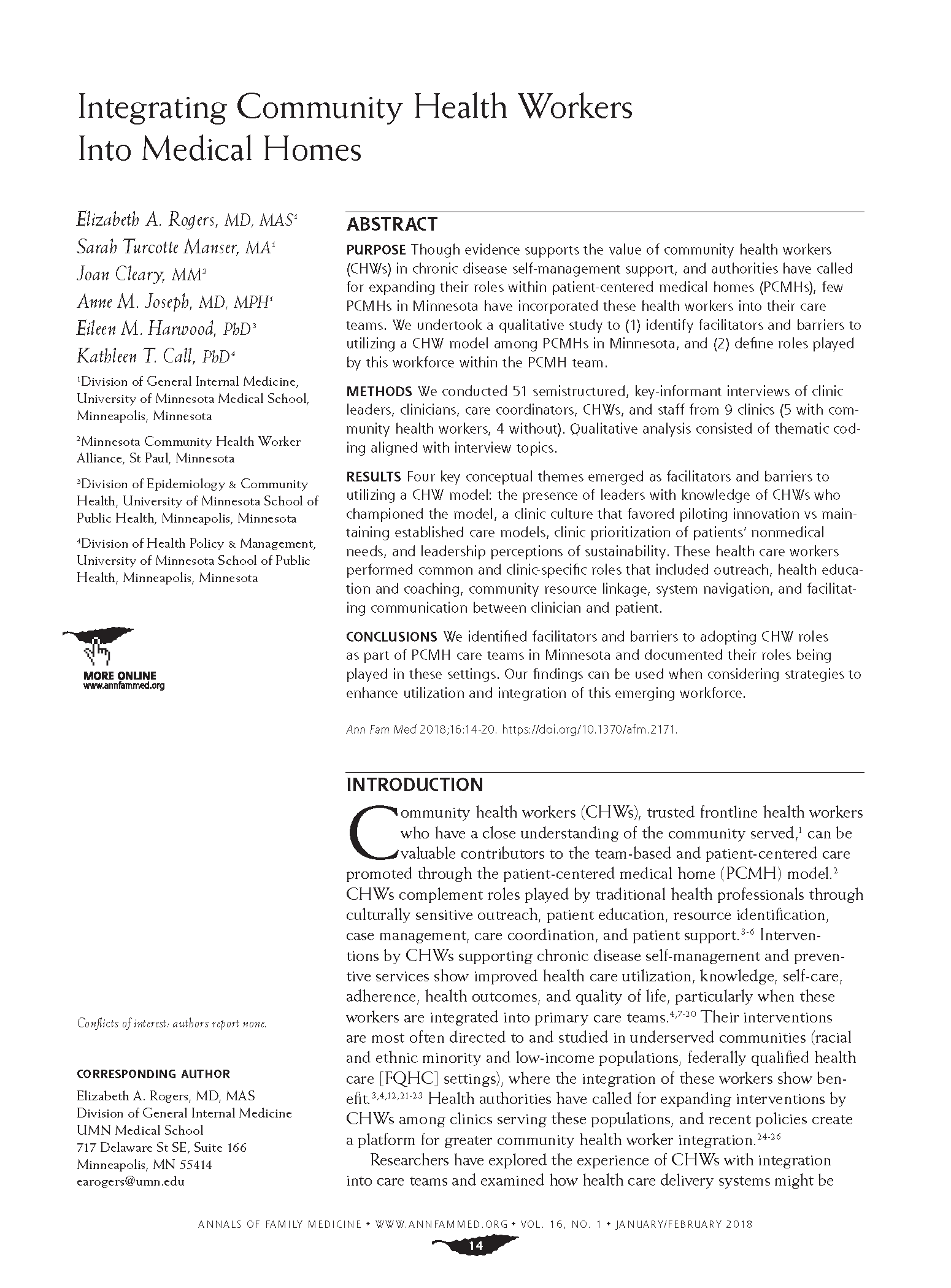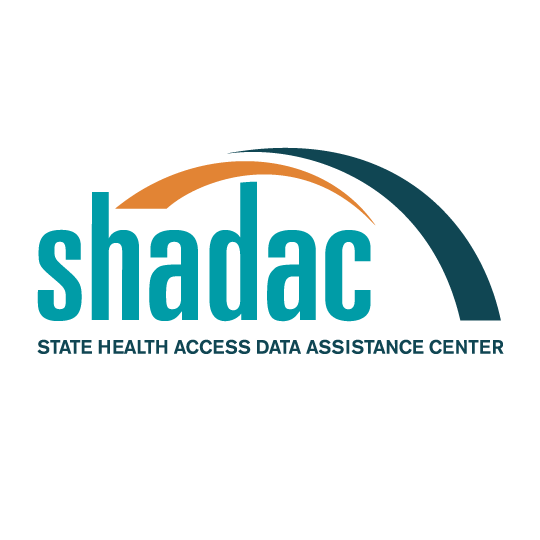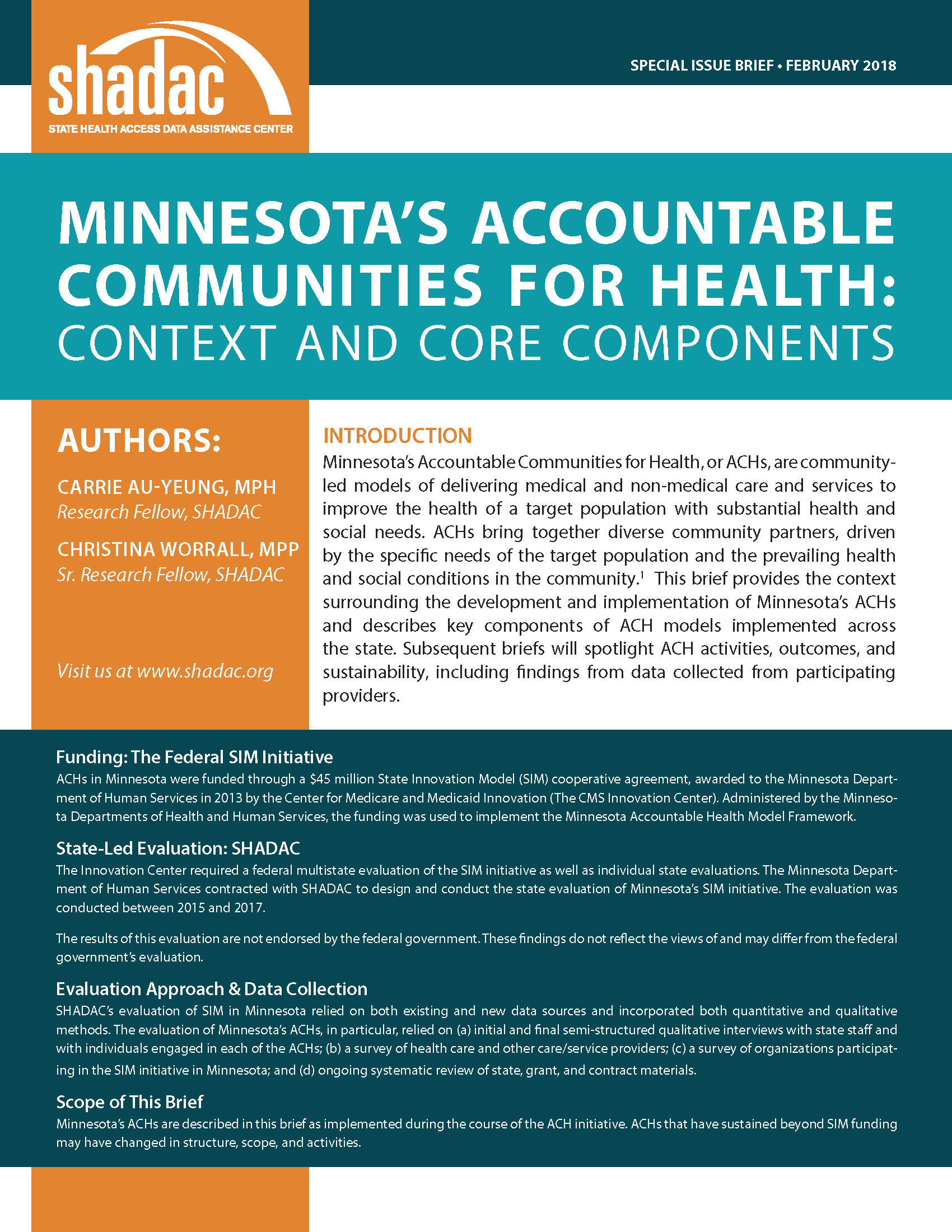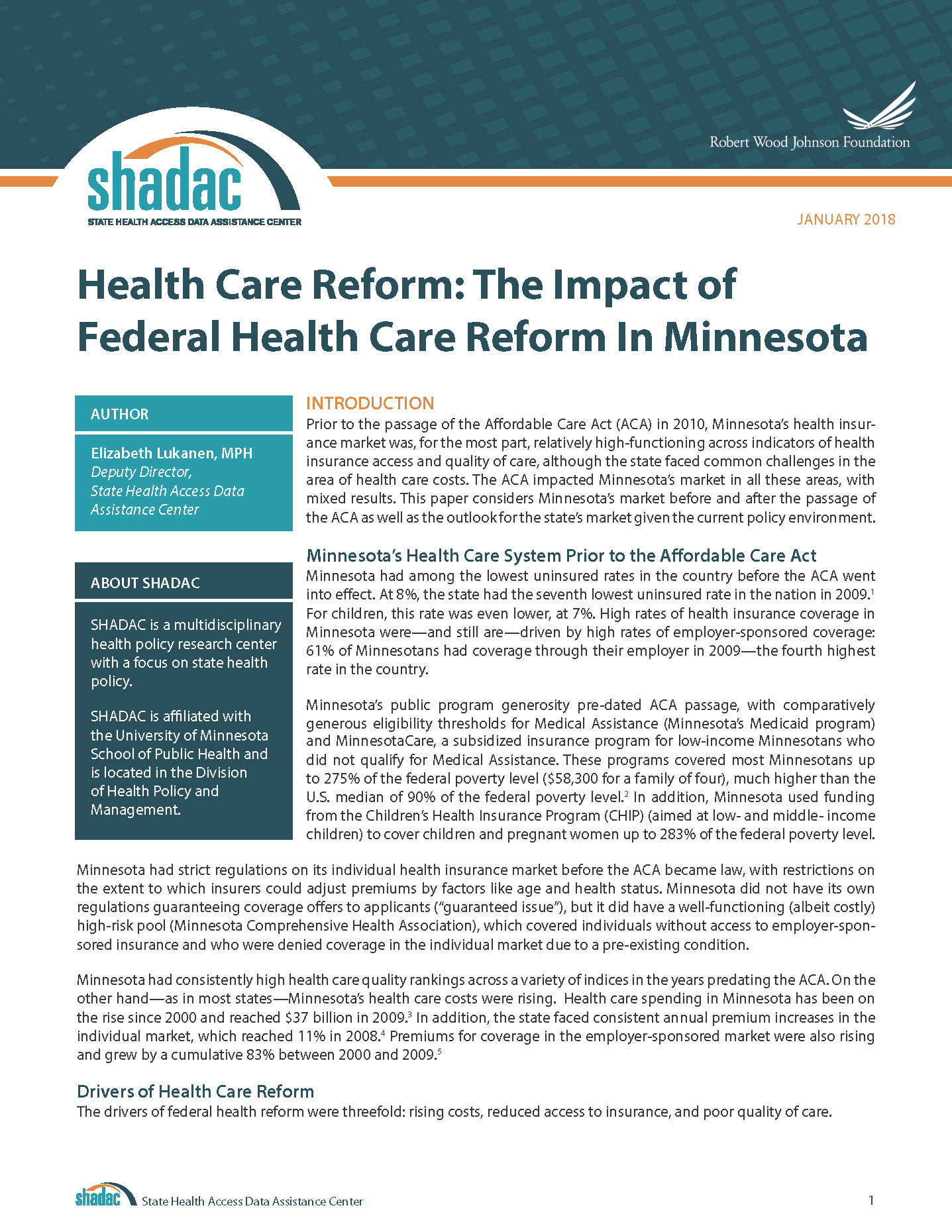Blog & News
SHADAC Brief Examines Minnesota's Accountable Communities for Health
October 15, 2019:SHADAC researchers released a new brief that provides the context surrounding the development and implementation of Minnesota’s Accountable Communities for Health, or ACHs, and describes key components of ACH models implemented across the state. The following are highlights from the brief.
ACHs: Defined
Minnesota's ACHs are community-led models of delivering medical and non-medical care and services to improve the health of a target population with substantial health and social needs. ACHs bring together diverse community partners, driven by the specific needs of the target population and the prevailing health and social conditions in the community. [1] The state awarded grants to fund the creation of 15 ACHs under the federal State Innovation Model (SIM) Initiative.
ACH Requirements
Core requirements for ACHs were to (1) establish a collaborative leadership structure that involved community partners; (2) develop and implement a community-based care coordination system or team; and (3) implement a population-based health prevention plan. Other key elements of Minnesota’s ACH model include a sustainability plan, a measurement plan, and participation in Learning Collaborative and evaluation activities.
ACH Characteristics
-
In all, eight ACHs were anchored in urban areas, six were located in rural areas, and one had both an urban and rural presence (Figure 1).
-
Three of the ACHs were outgrowths of an earlier Minnesota grant program, called the Community Care Team (CCT) pilot, which was administered from 2012 to 2013 by the Minnesota Department of Health’s patient-centered medical home initiative and was meant to expand beyond the medical focus of health care homes.
-
Eight ACHs established care coordination models that focused broadly on the medical and social needs of their target populations without regard to a specific category of health condition; four were focused on mental and behavioral health (e.g., depression, substance abuse, serious and persistent mental illness, etc.) within their target populations; and three focused on specific or comorbid chronic medical conditions within their target populations.
ACH Leadership and Partners
-
In all, ACHs identified 279 organizational partners, including partners who held both leadership and operational roles. The number of partners involved in any individual ACH ranged from six to 34.
-
In nearly all (14) ACHs, an Accountable Care Organization (ACO) representative or provider participant served on the ACH Leadership team. When the ACH target population overlapped, select ACO partners provided data, data analytics, and connections with providers and have been a source of patients/referrals for the ACHs.
-
Two-thirds (10) of ACHs involved a local public health partner in their work. ACHs with a public health partner reported that public health organizations brought a health promotion focus, hired key coordination staff, conducted population health activities, contributed data and evaluation expertise, and supported community engagement and relationship building.
-
Nine ACHs included at least one community or target population member on their leadership teams.
ACH Community-Based Care Coordination Systems or Teams
-
Because of the flexibility of the ACH program, as a result of which the ACHs were working with a broad range of target populations across a variety of settings, no single care coordination model accurately captures the various ACH care coordination approaches. Instead, ACH care coordination models can best be conceptualized by looking at the locus/anchor of care coordination and the intensity of care coordination services provided.
-
Nine ACHs conducted care coordination from the starting point of a medical facility or organization (clinic, hospital, health plan); four initiated care coordination within a community organization (social service agency, school, group living community); and two used a combination of medical and community-based starting points.
-
The care coordination efforts of about half of the ACHs fall at multiple points along a continuum of intensity that increases in tandem with patient needs. In these cases, services ranged from the provision of information and resources to a referral and/or handoff to an extensive wraparound. Other ACHs tended to concentrate their work at certain points along the continuum, depending largely on the needs of their target populations. Four ACHs, for example, targeted particularly high-need individuals such as those with developmental disabilities and mental illness, and therefore focused on high-intensity coordination work.
-
ACHs varied in terms of care coordination reach, with the average number of individuals reached per quarter by a given ACH ranging from fewer than 100 to more than 300 in 2016.
ACH Population-Health Based Prevention Plans
-
In developing their population-based prevention plans, ACHs frequently built upon prevention work intiatied or underway through other community efforts. For example, six ACHs leveraged the Statewide Health Improvement Program, three leveraged Community Transformation Grants, and nine leveraged other local public health initiatives.
-
All ACHs focused in whole or in part on the same populations for both their care coordination and population health components, with frequent overlap between care coordination and population health activities.
-
Where data was provided/available, ACHs reported reaching anywhere from 201 to 3,000 individuals each through population health programming and activities.
Funding: The Federal SIM Initiative
ACHs in Minnesota were funded through a $45 million state’s State Innovations Model (SIM) cooperative agreement, awarded to the Minnesota Department of Human Services in 2013 by the Center for Medicare and Medicaid Innovation (The CMS Innovation Center). Administered by the Minnesota Departments of Health and Human Services, the funding was used to implement the Minnesota Accountable Health Model Framework, for which SHADAC was the state evaluator.
State-Led Evaluation: SHADAC
The Innovation Center required a federal multistate evaluation of the SIM initiative as well as individual state evaluations. The Minnesota Department of Human Services contracted with SHADAC to design and conduct the state evaluation of Minnesota’s SIM initiative. The evaluation was conducted between 2015 and 2017. The results of this evaluation are not endorsed by the federal government. These findings do not reflect the views of and may differ from the federal government’s evaluation.
[1] Awsumb, B., Dobbe, C., Ly-Xiong, S., Rodriguez-Hager, R., Rydrych, D., & Terrill, W. (October 2016). "Accountable Communities for Health: Perspectives on Grant Projects and Future Considerations." Retrieved from http://www.dhs.state.mn.us/main/groups/sim/documents/pub/dhs-290682.pdf
Blog & News
New SHADAC Brief Explores the Impact of Federal Health Care Reform in Minnesota
February 09, 2018:A new brief from SHADAC deputy director Elizabeth Lukanen considers Minnesota’s health insurance market before and after passage of the Affordable Care Act (ACA) as well as the outlook for the state’s market given the current policy environment.
Minnesota’s Market before and after the ACA
The brief, “The Impact of Health Care Reform in Minnesota,” explores insurance coverage, public program generosity, insurance market regulations, and care quality and costs in Minnesota. Except in the area of costs, Minnesota had relatively high marks in these areas predating the ACA. Since the ACA went into effect, the state’s uninsured rate has declined further, although the cost of health care and coverage in Minnesota continues to rise, with a substantial number of Minnesotans (an estimated 50,000 to 70,000) foregoing coverage on the individual market between 2016 and 2017 due to costs.
Health Reform Today: Minnesota
The current health reform focus in Minnesota is the state’s individual insurance market, which state lawmakers have been working to stabilize following the exit of several major insurers. Lawmakers passed a premium relief bill in 2017 to assist consumers in the individual market with the cost of coverage. To further reduce premiums, the state established a state-funded reinsurance program that will reimburse insurers for 80% of insurance claims between $50,000 and $250,000.
Health Reform Today: The National Picture
There have been numerous attempts to repeal and replace the ACA since President Trump took office, but none has so far been successful. In the meantime, the Trump administration can significantly reform health care through other legislative vehicles and has taken steps to do so. Most recently, President Trump signed legislation overhauling the nation’s tax code that included a provision repealing the ACA’s individual mandate tax penalty. The impact of this particular change on the health insurance market as a whole—and the individual market in particular—is not yet known, but experts are concerned about the likelihood of healthier individuals choosing to opt-out of purchasing health insurance, leaving the market to support less healthy individuals.
Looking Ahead
Federal direction on health reform remains unclear, and this uncertainty may be taking a toll on coverage gains made under the ACA, with recent Gallup data showing an increase in the national uninsured rate since the end of 2016. In the face of federal uncertainty and the potential for coverage losses, many states, including Minnesota, are likely to continue to move forward with state-specific legislation to stabilize their individual markets and provide coverage for their residents.
Related
Blog & News
Now Available: Final Evaluation Report on the SIM Initiative in Minnesota
January 31, 2018:SHADAC’s final evaluation report on the SIM Initiative in Minnesota is now publicly available.
This report presents the final results of the state-level evaluation of Minnesota’s SIM initiative. SHADAC conducted this evaluation between January 2015 and September 2017 under a contract with the Minnesota Department of Human Services (DHS) and in collaboration with both DHS and the Minnesota Department of Health (MDH).
 This report draws on the first evaluation report (submitted in 2016) and details final results for the last two years of Minnesota’s initiative, with a focus on the following:
This report draws on the first evaluation report (submitted in 2016) and details final results for the last two years of Minnesota’s initiative, with a focus on the following:
- Minnesota’s SIM investments both within and outside of state government
- Key outcomes of the SIM initiative in Minnesota
- Outcomes and sustainability findings specific to the areas of:
- E-health
- Integrated Health Partnership (IHP) data analytics
- Team-based, integrated/coordinated care
- Accountable Communities for Health (ACHs)
- ACO alignment
- The continuation of Minnesota’s SIM model beyond SIM funding and future considerations for the state
Access SHADAC’s final evaluation report on the SIM initiative in Minnesota.
Access the executive summary of SHADAC’s final evaluation report.
Read a blog summarizing key findings from the evaluation of SIM in Minnesota.
Publication
Integrating Community Health Workers into Medical Homes
 Rogers, EA, Manser, ST, Cleary J, Joseph AM, Harwood EM, & Call KT. (2018). "Integrating Community Health Workers Into Medical Homes." Annals of Family Medicine 16(1): 13-20. doi: 10.1370/afm.2171
Rogers, EA, Manser, ST, Cleary J, Joseph AM, Harwood EM, & Call KT. (2018). "Integrating Community Health Workers Into Medical Homes." Annals of Family Medicine 16(1): 13-20. doi: 10.1370/afm.2171
This article details a qualitative analysis that (1) identified facilitators and barriers to utilizing a community health worker (CHW) model among patient-centered medical homes (PCMHs) in Minnesota; and (2) defined roles played by the CHW workforce within the PCMH team. Four themes emerged as facilitators and barriers: the presence of leaders with knowledge of CHWs who championed the model; a clinic culture that favored piloting innovation vs. maintaining established care models; clinic prioritization of patients' nonmedical needs; and leadership perceptions of sustainability. CHWs performed both common and clinic-specific roles that included outreach, health education and coaching, community resource linkage, system navigation, and facilitating communication between clinicians and patients.
Blog & News
Key Findings from the Evaluation of the SIM Initiative in Minnesota: Final Report Executive Summary Now Available
January 11, 2018:The executive summary of SHADAC’s final evaluation report on the SIM Initiative in Minnesota is now available.
| Background: SIM in Minnesota | |
|---|---|
|
In 2013, the state of Minnesota was awarded a cooperative agreement by the Center for Medicare and Medicaid Innovation (Innovation Center) under the State Innovation Model (SIM) initiative to implement and test a state-designed approach to care delivery transformation and payment reform. Under SIM, Minnesota aimed to develop a health care system that: provides patient-centered, coordinated care; holds providers accountable for costs and quality of care; aligns financial incentives to promote the Triple Aim; and implements collaborative approaches to set and achieve health improvement goals. Between 2015 and 2017, SHADAC conducted the state-level evaluation of Minnesota’s SIM initiative, called the Minnesota Accountable Health Model (the Model). |
Key Findings
The executive summary provides an overview of the key findings from the final results of SHADAC’s broad, initiative-level evaluation of Minnesota’s core SIM activities.
SHADAC highlights the following key results in particular that underscore the state’s progress in achieving its aims under SIM:
- The state expanded and advanced its Medicaid Accountable Care Organization (ACO) program and was viewed by participating provider systems as a leader among payers in data analytics and reporting.
- The number of SIM-collaborating organizations participating in alternative payment models increased over the period of the initiative, although this increase occurred primarily in the state’s Medicaid market.
- SIM investments in electronic health information exchange (HIE) increased provider connections to the state’s HIE infrastructure and expanded statewide HIE vendor capacity.
- State practice transformation programs and activities under SIM situated emerging professions practitioners (e.g., community health workers, community paramedics, etc.) in select front-line work settings; led to improvements in the capacity of participating providers and organizations to deliver coordinated care across settings; supported new and existing Health Care Homes; and facilitated the successful launch of Behavioral Health Homes.
- Community-based care coordination through Accountable Communities for Health (ACHs) led to improvements in care quality and patient outcomes, with individual ACH evaluations providing some evidence of cost savings.
- The state developed knowledge of the ACO market, engaged stakeholders, and built relationships that may help to support future discussions about ACO multi-payer alignment.
- Through joint-agency leadership, intentional stakeholder engagement, and the distribution of grants across the state with the flexibility to support innovative local reform models, DHS and MDH fostered new and strengthened existing relationships across sectors within the state, and broadened the conversation about health to one that goes beyond the medical care system to consider community characteristics and social determinants of health.
The Mark of SIM in Minnesota
While SIM and the infrastructure built around the initiative are coming to a close, Minnesota’s investments under SIM will continue to have an impact on the state and among provider communities: SIM lessons and investments are serving as a springboard for enhancements and adaptations in the state’s Medicaid ACO and Health Care Homes programs; over half of ACHs and one-third of e-Health initiatives have secured funding/resources to sustain their work in some form; the state is positioned to continue to advance e-Health; and a number of new capabilities and resources now exist that can provide future support to organizations across the state in their movement toward accountable care and community engagement.













